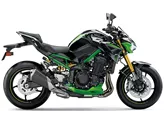Kawasaki Z 800 2013 vs. Kawasaki Z1000 2014

Kawasaki Z 800 2013

Kawasaki Z1000 2014
Visão geral - Kawasaki Z 800 2013 vs Kawasaki Z1000 2014
The Kawasaki Z 800 model year 2013 and the Kawasaki Z1000 model year 2014 are both naked bikes from Kawasaki, but they have some notable differences in terms of specifications and strengths.
Starting with the technical specifications, both bikes have an inline four-cylinder engine with liquid cooling. However, the Z1000 has a larger displacement of 1043cc compared to the Z800's 806cc engine. This results in a higher power output for the Z1000, with 142 horsepower compared to the Z800's 113 horsepower. The Z1000 also has a higher torque rating of 111 Nm compared to the Z800's 83 Nm.
In terms of suspension, both bikes feature upside-down telescopic forks at the front. However, the Z1000 offers more adjustability with compression, preload, and rebound adjustment, while the Z800 only has rebound adjustment. The same applies to the rear suspension, with the Z1000 offering more adjustability options compared to the Z800.

Kawasaki Z 800 2013
When it comes to the chassis, the Z800 has a steel frame, while the Z1000 has an aluminum frame. This difference in frame material may contribute to the Z1000's lighter weight of 221 kg compared to the Z800's 229 kg.
Both bikes have dual disc brakes at the front with four-piston calipers, but the Z1000 features radial technology and petal discs, which may provide improved braking performance compared to the Z800's petal discs.
In terms of dimensions, both bikes have a 17-inch front wheel with a width of 120mm. However, the Z1000 has a wider rear tire with a width of 190mm compared to the Z800's 180mm. The Z1000 also has a slightly shorter wheelbase of 1435mm compared to the Z800's 1445mm. The seat height is lower on the Z1000 at 815mm compared to the Z800's 834mm.
In terms of fuel capacity, the Z800 has a larger tank with a capacity of 17 liters, while the Z1000 has a smaller tank with a capacity of 15 liters.

Kawasaki Z1000 2014
Moving on to the strengths and weaknesses of each bike, the Z800 is praised for its attractive and robust appearance, confident acceleration, relaxed geometry, and powerful brakes. However, it is noted that the legroom is somewhat limited.
On the other hand, the Z1000 is praised for its sophisticated design, extremely pleasant handling, pleasant sound, and good brakes. However, it is mentioned that the purchase price is high compared to the S1000R.
In conclusion, while both bikes have their strengths and weaknesses, the Z1000 offers a more powerful engine, more adjustability in the suspension, a lighter weight, and a slightly more advanced chassis. However, it is important to consider the higher purchase price of the Z1000 compared to the Z800. Ultimately, the choice between the two models will depend on the rider's preferences and budget.
Especificações técnicas Kawasaki Z 800 2013 em comparação com Kawasaki Z1000 2014
Prós e contras em comparação
Prós e contras em comparação
Kawasaki Z 800 2013

No geral, a Z800 teve um desempenho sensacional. Considerando o facto de que nada foi alterado ou optimizado no veículo para além do silenciador traseiro Remus, o resultado final foi excelente.
Kawasaki Z1000 2014

A Kawasaki Z1000 (2014) é uma afirmação contra a tendência eletrónica do seu tempo - e é exatamente isso que a torna especial hoje em dia. O seu caraterístico motor de quatro cilindros, a sua mecânica direta e o seu enfoque intransigente no essencial são um acorde numa época em que muitas motos se tornaram computadores. Sim, não tem os modernos Sistemas Avançados de Assistência ao Condutor e uma proteção perfeita contra o vento. Mas oferece uma experiência de condução autêntica de uma naked bike, aliada à fiabilidade japonesa e a custos de manutenção razoáveis. A Z1000 não é uma moto para viciados em folhas de dados ou fãs de eletrónica - é uma moto para pessoas que ainda querem tomar as suas próprias decisões quando conduzem. Uma moto honesta e com carácter que continua a inspirar mesmo após anos e que cumpre o seu papel como alternativa emocional à era moderna digital.
Comparação de preços Preço médio de mercado Kawasaki Z 800 vs Kawasaki Z1000
There are a few key differences between a Kawasaki Z 800 2013 and a Kawasaki Z1000 2014. In terms of price, the actual average price of a Kawasaki Z1000 2014 is about 38% higher. Compared to Kawasaki Z1000 2014 there are less Kawasaki Z 800 2013 bikes available on the 1000PS.de Marketplace, specifically 7 compared to 12. It takes less time to sell a Kawasaki Z 800 with 56 days compared to 75 days for a Kawasaki Z1000. Since model year 2013 1000PS.de editors have written 11 reviews for the Kawasaki Z 800 and 41 reviews for the Kawasaki Z1000 since model year 2005. The first review for the Kawasaki Z 800 was published on 06/09/2012 and now has more than 8.100 views. This compares to more than 5.800 views for the first review on Kawasaki Z1000 published on 02/09/2002.


















